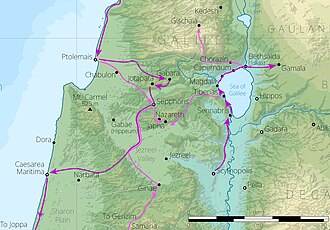Discover Your Roots
SIGN UPDiscover Your Roots
SIGN UPGalilee is a gender-neutral name of English origin, meaning "Country Of Gentiles." The name is derived from the region located in northern Israel and southern Lebanon, known for its rocky terrain, high mountains, and thriving flora and fauna. The region encompasses the Upper Galilee and Lower Galilee, and is historically significant as the tribal region of Naphthali and Dan according to the Hebrew Bible. Galilee was predominantly Jewish in the early Roman period and has been a site of significant demographic and political changes throughout history. Galilee is also a popular tourist destination, attracting Christian pilgrims to visit sites of biblical importance. The cuisine of the Galilee is diverse, characterized by light meals, dairy products, herbs, freshwater fish, olives, pomegranates, wine, and traditional dishes flavored with regional ingredients.

The Galilee campaign, also referred to as the Northern Revolt, occurred in 67 CE when Roman general Vespasian invaded Galilee on the orders of Emperor Nero to suppress the Great Revolt of Judea. The campaign is well-documented, and one of the Jewish rebel leaders, Josephus, was captured. Josephus established a friendship with Vespasian, who later became Roman Emperor, and was eventually freed and given a place of honor in the Flavian dynasty. The Galilee had a significant Jewish population living in easily fortifiable villages, posing a challenge for the Romans. Vespasian gathered an army and established a base in Akko-Ptolemais, launching an offensive against the rebels. Several towns surrendered to the Romans, and Yodfat fell after a 47-day siege, resulting in a significant loss of life. Josephus, who led the defense of Yodfat, surrendered to the Romans and prophesied Vespasian's rise to emperor, leading to the sparing of his life. This campaign is extensively detailed in Josephus's work "The Jewish War," providing a comprehensive account of the sieges and internal Jewish politics during the Galilee campaign.




All images displayed on this page are sourced from Wikipedia or Wikimedia Commons.We use these images under their respective Creative Commons or public domain licenses. Wherever applicable, author attributions and license information are provided. If you believe an image is used incorrectly or outside its license terms, please contact us so that we can review and correct the issue.